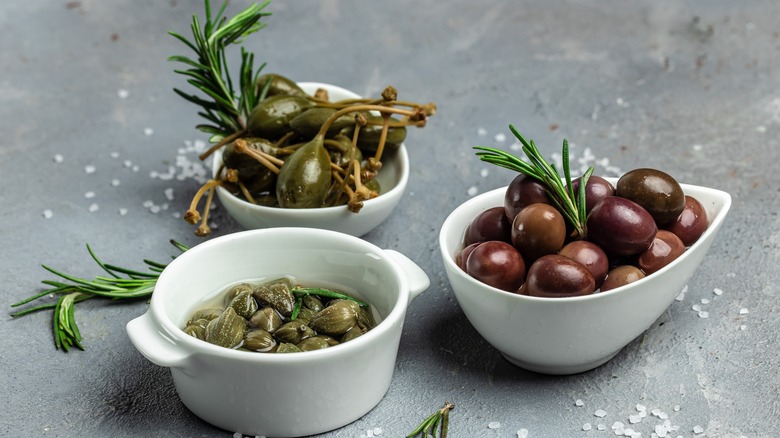Elevate Your Store-Bought Salsa With Some Simple Briny Add-Ins
Olives, capers, and salsa don't usually go together in the same sentence. But what if you've been missing out this whole time? Just as the dance form salsa is full of spice, so is the sauce, and adding olives and capers to the mix is like adding a new dance step, making it all the more zesty. So the next time you buy a jar of salsa at the store, be sure to pick up some jars of olives and capers along with it. That's because you'll be adding these briny ingredients to store-bought salsa, elevating it to new heights.
In Veracruz, a port city in Mexico, adding brined olives and capers to salsa is the norm. Brined olives and capers in salsa pleasantly surprise the palate with pops of flavor. Veracruz is known for using olive-caper salsa with grilled fish because of its location on Mexico's Gulf Coast, where there's an abundance of red snapper. The port city's use of olives and capers in salsa is often credited to the influence of Spanish cuisine, a result of the explorers arriving here.
You don't need to make your salsa from scratch though. Veracruz-style salsa can be easily recreated by adding olives and capers to store-bought salsa.
The best pairings of olives and capers with salsa
The three most common types of salsa you'll find in a supermarket are pico de gallo, red salsa (also known as salsa roja), and green salsa (also known as salsa verde). Pico de gallo and red salsa are both tomato-based salsas, with the latter containing much more liquid than the former. Green salsa, on the other hand, is tomatillo-based. Overall, store-bought salsa often tastes more acidic than homemade salsa due to added lemon juice. Capers are a particularly good addition to store-bought salsa because they play well with acidic flavors, such as lemon.
Pico de gallo is uncooked, which gives it a fresh flavor. Adding brined black olives, which are nutty in taste and meaty in texture, to pico de gallo would perfectly balance its freshness. Green olives and capers will also go well with pico de gallo, adding saltiness. Similarly, red salsa — which has a thicker texture — would do well with brined green olives and capers. The punchy, salty taste of green olives and capers balances out the strong flavors of onion, garlic, and jalapeño in red salsa. Finally, green salsa has a pico de gallo-esque freshness due to its base of naturally acidic tomatillos. Capers are a good add-in because of their ability to counter acidity. Black olives are also a good choice since their earthy flavors complement the tangy punch of green salsa.
Ways to use olive-caper salsa
What could be easier than a snack that consists of store-bought salsa, briny add-ins, and some tortilla chips? Fresh salsas like pico de gallo and salsa verde with olives and capers stirred in are ideal for the summertime when it's too hot to cook. Olive-caper salsa is also a great way to impress family and friends the next time you host. Whip up a Veracruz-style salsa in no time with store-bought salsa and scoop it over grilled fish to wow your guests. Grilling your fish isn't a hard requirement because Veracruz-style salsa goes well with fish no matter how you prepare it, whether it's poached, steamed, or fried. Alternatively, add olive-caper salsa to spicy crab and tomato empanadas.
Other ways to use olive-caper salsa are on basically anything you would use regular salsa on. This can be tacos, tuna tostadas, and even scrambled eggs. Protein-rich dishes like scrambled eggs are perfectly balanced by the salty, punchy flavor of capers and olives stirred into salsa. Or jazz up some easy chicken enchiladas with an olive-caper salsa. Briny olives and capers in salsa can also add a fresh element to rich Mexican classics like refried beans and rice.


